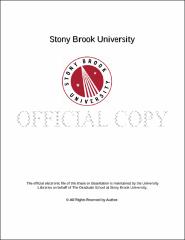| dc.identifier.uri | http://hdl.handle.net/1951/60214 | |
| dc.identifier.uri | http://hdl.handle.net/11401/71049 | |
| dc.description.sponsorship | This work is sponsored by the Stony Brook University Graduate School in compliance with the requirements for completion of degree. | en_US |
| dc.format | Monograph | |
| dc.format.medium | Electronic Resource | en_US |
| dc.language.iso | en_US | |
| dc.publisher | The Graduate School, Stony Brook University: Stony Brook, NY. | |
| dc.type | Dissertation | |
| dcterms.abstract | During central nervous system (CNS) development, individual oligodendrocytes myelinate multiple axons, thus requiring the outgrowth
and extensive branching of oligodendroglial processes. Extrinsic cues including the extracellular matrix (ECM) molecule laminin regulate oligodendrocyte
maturation; indeed, laminin-deficient mice have fewer myelinated axons, which may indicate a defect in the ability to properly extend and branch processes.
It remains unclear, however, to what extent ECM receptors contribute to oligodendroglial process remodeling itself. Here I report that the ECM receptor
dystroglycan is necessary for laminin enhancement of filopodial formation, process outgrowth, and process branching in differentiating oligodendroglia.
During early oligodendroglial differentiation, the disruption of dystroglycan-laminin interactions, via blocking antibodies or dystroglycan siRNA, resulted
in decreased filopodial number and length, decreased process length, and decreased numbers of primary and secondary processes. Later in oligodendrocyte
differentiation, dystroglycan-deficient cells developed fewer branches, thus producing less complex networks of processes as determined by Sholl analysis.
In newly-differentiating oligodendroglia dystroglycan was localized in filopodial tips, while in more mature oligodendrocytes dystroglycan was enriched in
FAK-positive focal adhesion structures. In addition to its role in promoting cytoskeletal reorganization, I have recently begun investigating a novel
signaling role for dystroglycan in the nucleus. Our preliminary evidence suggests that dystroglycan localizes to the nucleus in oligodendrocyte progenitors
(OPCs) and may play a role in dystroglycan-dependent modulation of oligodendroglial differentiation. Î -dystroglycan expression in the nuclear fraction of
proliferating OPCs is higher than in differentiating oligodendrocytes; furthermore, I have detected an increased proportion of a cleaved form of
Î -dystroglycan in the nucleus of proliferating OPCs relative to differentiated oligodendrocytes. Analysis of OPCs expressing a dystroglycan deletion
construct reveal a preferential localization of the cytoplasmic domain of Î -dystroglycan to the nucleus, and decreased proliferation in response to growth
factor stimulation. Our results suggest that dystroglycan may contribute to the overall myelinogenic capacity of individual oligodendroglia by influencing
oligodendroglial process dynamics through dystroglycan-laminin interactions, and potentially modulating differentiation by signaling in the nucleus of
oligodendroglial progenitors. | |
| dcterms.abstract | During central nervous system (CNS) development, individual oligodendrocytes myelinate multiple axons, thus requiring the outgrowth
and extensive branching of oligodendroglial processes. Extrinsic cues including the extracellular matrix (ECM) molecule laminin regulate oligodendrocyte
maturation; indeed, laminin-deficient mice have fewer myelinated axons, which may indicate a defect in the ability to properly extend and branch
processes. It remains unclear, however, to what extent ECM receptors contribute to oligodendroglial process remodeling itself. Here I report that the ECM
receptor dystroglycan is necessary for laminin enhancement of filopodial formation, process outgrowth, and process branching in differentiating
oligodendroglia. During early oligodendroglial differentiation, the disruption of dystroglycan-laminin interactions, via blocking antibodies or
dystroglycan siRNA, resulted in decreased filopodial number and length, decreased process length, and decreased numbers of primary and secondary processes.
Later in oligodendrocyte differentiation, dystroglycan-deficient cells developed fewer branches, thus producing less complex networks of processes as
determined by Sholl analysis. In newly-differentiating oligodendroglia dystroglycan was localized in filopodial tips, while in more mature
oligodendrocytes dystroglycan was enriched in FAK-positive focal adhesion structures. In addition to its role in promoting cytoskeletal
reorganization, I have recently begun investigating a novel signaling role for dystroglycan in the nucleus. Our preliminary evidence suggests that
dystroglycan localizes to the nucleus in oligodendrocyte progenitors (OPCs) and may play a role in dystroglycan-dependent modulation of
oligodendroglial differentiation. Β-dystroglycan expression in the nuclear fraction of proliferating OPCs is higher than in differentiating
oligodendrocytes; furthermore, I have detected an increased proportion of a cleaved form of Β-dystroglycan in the nucleus of proliferating OPCs
relative to differentiated oligodendrocytes. Analysis of OPCs expressing a dystroglycan deletion construct reveal a preferential localization of the
cytoplasmic domain of Β-dystroglycan to the nucleus, and decreased proliferation in response to growth factor stimulation. Our results suggest
that dystroglycan may contribute to the overall myelinogenic capacity of individual oligodendroglia by influencing oligodendroglial process dynamics
through dystroglycan-laminin interactions, and potentially modulating differentiation by signaling in the nucleus of oligodendroglial progenitors. | |
| dcterms.available | 2013-05-24T16:38:14Z | |
| dcterms.available | 2015-04-24T14:45:43Z | |
| dcterms.contributor | Colognato, Holly | en_US |
| dcterms.contributor | Levine, Joel M | en_US |
| dcterms.creator | Eyermann, Christopher Edward | |
| dcterms.dateAccepted | 2013-05-24T16:38:14Z | |
| dcterms.dateAccepted | 2015-04-24T14:45:43Z | |
| dcterms.dateSubmitted | 2013-05-24T16:38:14Z | |
| dcterms.dateSubmitted | 2015-04-24T14:45:43Z | |
| dcterms.description | Department of Molecular and Cellular Pharmacology | en_US |
| dcterms.extent | 149 pg. | en_US |
| dcterms.format | Application/PDF | en_US |
| dcterms.format | Monograph | |
| dcterms.identifier | http://hdl.handle.net/1951/60214 | |
| dcterms.identifier | http://hdl.handle.net/11401/71049 | |
| dcterms.issued | 2012-12-01 | |
| dcterms.language | en_US | |
| dcterms.provenance | Made available in DSpace on 2013-05-24T16:38:14Z (GMT). No. of bitstreams: 1
StonyBrookUniversityETDPageEmbargo_20130517082608_116839.pdf: 41286 bytes, checksum: 425a156df10bbe213bfdf4d175026e82 (MD5)
Previous issue date: 1 | en |
| dcterms.provenance | Made available in DSpace on 2015-04-24T14:45:43Z (GMT). No. of bitstreams: 3
StonyBrookUniversityETDPageEmbargo_20130517082608_116839.pdf.jpg: 1934 bytes, checksum: c116f0e1e7be19420106a88253e31f2e (MD5)
StonyBrookUniversityETDPageEmbargo_20130517082608_116839.pdf.txt: 336 bytes, checksum: 84c0f8f99f2b4ae66b3cc3ade09ad2e9 (MD5)
StonyBrookUniversityETDPageEmbargo_20130517082608_116839.pdf: 41286 bytes, checksum: 425a156df10bbe213bfdf4d175026e82 (MD5)
Previous issue date: 1 | en |
| dcterms.publisher | The Graduate School, Stony Brook University: Stony Brook, NY. | |
| dcterms.subject | Beta Dystroglycan, Dystroglycan, Nucleus, Oligodendrocyte, Process Branching, Process Outgrowth | |
| dcterms.subject | Cellular biology--Neurosciences | |
| dcterms.title | The Role of Dystroglycan in Differentiating Oligodendroglia and CNS Myelination | |
| dcterms.type | Dissertation | |

